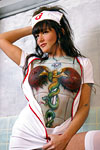Article/Interview with Dave Schwartz
of the website DaBelly.com
Published in February 2006
http://www.dabelly.com/features/feature197.htm
|
Is it me or has body painting become the latest haute couture? Over the past several months it seems the topic has appeared on our radar screens a multitude of times. Friends have brought it up in conversations, we're even getting press releases announcing exhibitions. Iíve also witnessed local clubs bringing in artists as part of the eveningís entertainment and very noticeably art galleries are hosting exotic art exhibitions and involving the public by bringing in body paint artists to demonstrate their work. Here at DaBelly weíve ventured into the culture of body modification, from tattooing to piercing, but we havenít touched on body painting. Being primarily a music e-zine, we have certainly run across our share of latex-clad ladies, but it has often been relegated to concert festivals like "Ozzfest." Who can condemn a woman for wanting to trade a cotton blend T-shirt for mural of Molly Hatchet emblazoned across her chest? Alright, perhaps thatís a less sophisticated example of the artistic phenomenon in question, but I think you understand where Iím going with this. So recently I grabbed a date and we went to check out these events and see firsthand what the buzz is all about. Our first event was in conjunction with Phoenixís monthly First Friday Art Walk and held at the Soul Invictus gallery. By the way, these First Friday events are cropping up in most major cities across America and certainly are worthy of your support. The PR release billed the event as "interactive art, live performance and off-beat musical interludes." It was certainly all of the above replete with the belly dance troupe, Anaya Tribal Fusion, fire dancers, Breath and Fire, musical accompaniment by techno-baroque avatar Tristan Gregorie and of course Ian Wender and his team of artists. For the evening, Wender brought in five models and over the course of hours transformed the human canvas into a whirlwind of color and texture. Bright lights and brush strokes greeted hundreds of guests as they made their way from gallery to gallery. The openness of the event certainly provoked a dialog as the models were transformed from nudity into art. Many stayed to watch, while others, occasionally surprised by the exhibition, continued with their walk.
I spoke with Greenawalt during the show and several days later we had a chance to sit down. DB: You have a background in art, photography and music and engineering, this is kind of an unusual mix - engineers are analytical, while artists are more emotional - do you find both sides of the brain compliment or compete? MG: I would say they compliment and I would say that I
bring a little bit of each into the other. And the reason I
say that, for example, in engineering Iíve become artsy at
times and with the way I try to solve problems. I think that
Iím more creative than someone that just goes by the
book. But then again, on the art side, Iím like a
technological geek. I had a digital camera long before a lot
of other people did. Because I realize the importance of
getting my art onto the internet I learned HTML code. Iíve
had my own website since 1997, '98. When all of this, this
thing called the internet, was being talked about I was
already researching how to write HTML code. Even though thatís
not specifically an art, itís an example how Iíve been
able to bring engineering and technology in and enhance my
art. Another example is PhotoShop. I do very few finished
pieces in PhotoShop but itís a program that is essential
to transferring my artwork to the visual realm for people to
see. MG: I would have to say, in one word, impact. Iíve taken art classes in all different mediums. Iíve done pencil drawings. As a child, eight or nine years old, I was enrolled in private art classes where I learned all the techniques like shading and perspective, the basics of drawing. And then I advanced into oil painting where I learned the basics of color and mixing colors. Throughout all of that I was able to produce 2-dimensional art and got pretty good reactions from people. I entered things in the state fair and won awards, but ironically any time I showed a picture of my 2-D work I really felt that I got this, even if someone was very impressed by the art, the conversation pretty much ended after they said, "Thatís really good." With body art, the conversation has just gotten started with someone sees my work. People start asking, "How do you find your models? What kind of paint do you use?" to all the questions that you have. People never reacted like this to my 2-D art. So this has been a way of taking the talents that I do have and accentuating them because people notice them more. I should also add to that that itís an art form that I feel an opportunity to be a little bit like a pioneer or more individualized in because this isnít a very saturated market at this point in time.
MG: In all honesty I donít see the trend. What I see is peaks and valleys. In other words, for a long time I donít see anything and then suddenly I see a lot. I wouldnít say that itís becoming more and more common. In studying body art, itís been around for ages, it goes way back to tribal paints from Africa and even our Native American Indians; everyone has used it. Itís not a new art form at all. I would even suggest that it was more popular in the '70s than it is today because they were doing peace and love and all that stuff at Woodstock. There was a whole genre of people that enjoyed painting on themselves to get a message across. I would say that in the '90s the art form kind of died. As I do research I donít find hardly anything from that era, the only things that popped up from my perspective was the Demi Moore cover of Vanity Faire. That was by a makeup artist by the name of Joanne Gair. And then Joanne Gair again struck in í98 with the Sports Illustrated swimsuits that were painted on. So I would say that single handedly sheís the one who has brought out or brought back body painting. And now I see makeup artists are expanding beyond just faces, they are the ones that are getting involved in the professional ads that utilize body art. But the only places that I have found pure body art is in Playboy, theyíre doing it occasionally, and the internet-- there is a lot you can find on the internet. DB: Well thatís certainly the perspective I was drawing from when I suggested that body art is evolving. Perhaps the evolution is more in venue than in the art itself. Sure subject matter changes over time, but now there seems to be a whole new storefront for an artist to show their wares. If the Internet is anything itís an opportunity for someone or something to be discovered. You brought up that the commercial entities, in their rare uses of body art, have resorted to using makeup artists rather than body paint artists. Do you think this is more of a case of familiarity? MG: I believe that the makeup artists have been hired to do the makeup anyway so when ever there is an expanded need Iím sure they ask the makeup artist if they are capable and of course they want the work so theyíll say yes. There was one other thing I wanted to mention. You know, with the internet you have people realizing what all is going on in places like FantasyFest and Mardi Gras that are not internet venues. They are live venues, but nevertheless the numbers of people attending these festivals are relatively low in comparison to the number of people that view images from these events on the internet.
MG: I havenít yet attended FantasyFest, but the one thing that I think is interesting is that, one of my other hobbies is song writing. I know that this goes on a sidetrack for a bit but it comes back around. All these people that try to be famous singers find that they suddenly have to hide from the public and paparazzi. I always thought it was funny that the songwriters would make as much money as the singers were but rarely had to deal with the fame. And I think itís interesting that an artist, and in body painting most specifically, has that same opportunity that you mentioned he can try to get famous by going to FantasyFest, but ironically no one cares who the artist was, they just remember the work; they just want to see the images. And thatís kind of neat to me because if someone were to say, "Have you seen the one with the two frogs?" and if I were to say, "Yes, I did that," you get a little bit of credibility. Joanne Gair, I keep coming back to her, is a good example. Most have never heard of her, but if you mention the painted swimsuits in Sports Illustrated or Demi Mooreís cover and everybody knows the work. DB: You know another example of that at the moment is the image of the four or five girls with the Pink Floyd album covers painted across their backs. MG: Absolutely, I wish I knew who did that. DB: So what do you consider your genre of art? Is this more of a pop culture thing or do you fall into surrealism? Where do you think this all goes? MG: Thatís a great question and Iím not sure I have an answer for it. To me, itís a genre in of itself, but luckily for me, itís wide open. Thereís a guy named LeRoy Roper. If you get a chance go to his site, www.leroyroper.com, you will see that he is really sticking to a real coherent style. In other words, as many different things that he does it all has a similarity. My stuff is kind of the opposite. Iíve been able to do a wide variety of styles. I like to go to SciFi conventions and paint something that is SciFi-looking. I go to these night club events and Iím able to do wild animals or logos or even an album cover. So I feel that I havenít had to sign onto one style and stick to it. The body painting itself has been the one common thread. If you were take other artists and stick them into a pop culture style they would pick their own medium, for example oil paintings. Iíve found that typically the more famous artist do eventually get pigeonholed into one style. So I think I will eventually either settle on one style or be one of the rare few that breaks through and has several styles that appease a wide audience. DB: It seems that body painting is, for lack of a better analogy, a spectator sport. When you set up and begin painting you will, of course, have a half dozen guys gather around, but also women too. Some of the guys are there to gawk, others are fascinated by your work. And the women seem to bridge between casual interest and considering involvement. Do you find your art to be an interactive process beyond just the model?
DB: Given that your art really is a moment in time that you capture with photography, do you find yourself revisiting certain works? Do you ever go back and recreate what you have already done? MG: No, as much as possible I try not to repeat. To my knowledge Iíve done a spider twice, just because someone saw it. They looked through my portfolio and saw the spider and said that they wanted it done. I wanted to do something different, but they really wanted the spider, that has really been the only time that I did a copy on purpose. I had quite a few that wanted to be painted like cats. Luckily, Iíve been able to do different spot patterns and use different colors-- Iíve done a lion, a cheetah, a snow leopard and wild cats. Itís a popular style that people want to be painted as. But I try not to repeat myself. DB: My last and I guess an obvious question. Where do you find your models? MG: Iíve got a mixed bag of where Iíve found my models. Iíd have to say that www.onemodelplace.com is really where Iíve gotten a majority of my models. Itís a web site that allows amateur models to post their portfolios and thereís a way to e-mail the models directly. I write and explain that Iím looking for someone to do some nude modeling for free. Most times theyíre interested in getting a tearsheet out of it or something for their portfolio. In other corporate settings, say an alcohol company hires me, theyíre usually paying for the model. In those cases, Iím meeting a model for the first time. And lastly there are people that find me. There have been quite a few women that e-mail me and say they are interested and want to get involved. I then ask them to send me what portfolio pictures they have. I try to work with models that are at least semi-established. A lot of that is because this is work and if you have someone who really just doesnít understand how to pose or isnít photogenic you have problems. A special thanks go out to all the artists and models. If this topic interests you be sure to check out Mark Greenawaltís Web site and some of the others mentioned in this article. And when in Phoenix, be sure to check out the Soul Invictus gallery. Return to DaBelly |
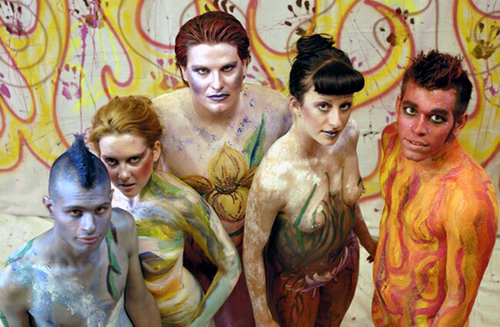 Body
Painting
Body
Painting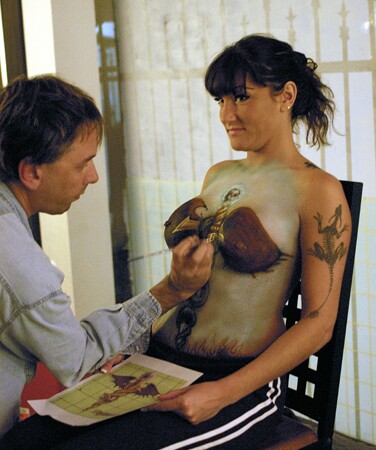 Several
nights later, and in conjunction with another First Friday
event, was the "Annual Sex, Drugs, and Rock & Roll
Event" at
Several
nights later, and in conjunction with another First Friday
event, was the "Annual Sex, Drugs, and Rock & Roll
Event" at 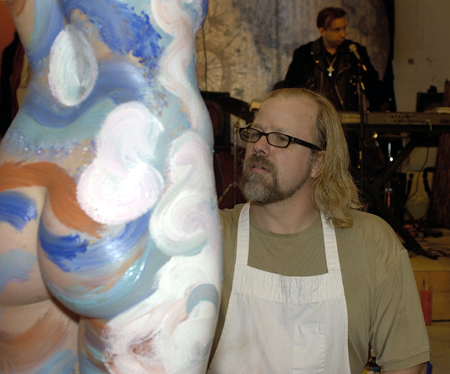 DB:
Now youíve already touched a bit on my next question. I
wanted to talk a little bit about the evolution of body
painting. Body painting seems to be evolving from the
concert venue or outdoor festival to a more mainstream
acceptance (advertisements and so on). What do you think is
driving this change?
DB:
Now youíve already touched a bit on my next question. I
wanted to talk a little bit about the evolution of body
painting. Body painting seems to be evolving from the
concert venue or outdoor festival to a more mainstream
acceptance (advertisements and so on). What do you think is
driving this change?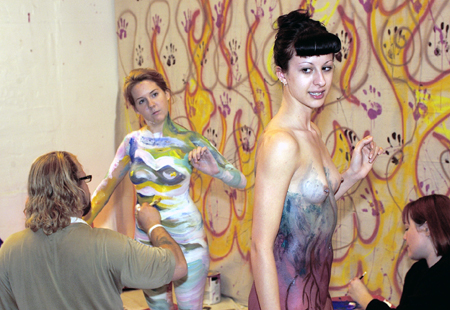 DB:
Itís interesting because FantasyFest is largely just a
body painting festival. Itís the thing to do when
attending. Certainly as an artist you can make a name for
yourself by going to the festival and painting as many
bodies as possible. I know they have body art competitions
and that there is a level of prestige associated with having
a winning design.
DB:
Itís interesting because FantasyFest is largely just a
body painting festival. Itís the thing to do when
attending. Certainly as an artist you can make a name for
yourself by going to the festival and painting as many
bodies as possible. I know they have body art competitions
and that there is a level of prestige associated with having
a winning design.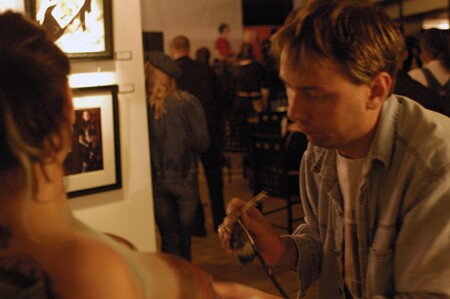 MG:
From your perspective, about 50 percent of what I do you
might call interactive. But ironically, from my perspective,
Iím still shooting for a bottomline-- the artwork is being
done for the final image. The photograph is the final step
of the process. But I think what youíre considering to be
interactive is more just inviting people to come watch what
I do. Itís just like the character artists that set up in
a mall. The main goal is to produce a product, but theyíre
also doing it to entertain and entice an audience. As far as
being interactive, I welcome questions while Iím working
and I encourage the model to interact. Everyone has
questions like, "Whatís it feel like?," "Is
it cold?," "Does it tickle?" I encourage
people to ask and the models enjoy giving their answers.
People ask me the type to paint I use and how long Iíve
been doing this. Itís really more of a case of opening up
my shop to let people see what I do. The interesting thing
to me is that so very few people get to see the process of
painting but everyone can see the final product.
MG:
From your perspective, about 50 percent of what I do you
might call interactive. But ironically, from my perspective,
Iím still shooting for a bottomline-- the artwork is being
done for the final image. The photograph is the final step
of the process. But I think what youíre considering to be
interactive is more just inviting people to come watch what
I do. Itís just like the character artists that set up in
a mall. The main goal is to produce a product, but theyíre
also doing it to entertain and entice an audience. As far as
being interactive, I welcome questions while Iím working
and I encourage the model to interact. Everyone has
questions like, "Whatís it feel like?," "Is
it cold?," "Does it tickle?" I encourage
people to ask and the models enjoy giving their answers.
People ask me the type to paint I use and how long Iíve
been doing this. Itís really more of a case of opening up
my shop to let people see what I do. The interesting thing
to me is that so very few people get to see the process of
painting but everyone can see the final product.